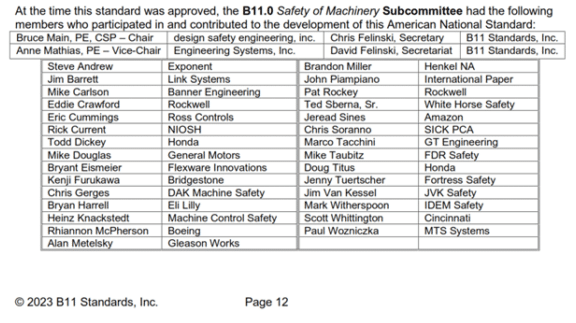Last edit: 30/04/2024
Overview and history

The B11 series of machinery safety standards are over 100 years old, beginning with the first standard on the safety requirements for power presses in 1922. Since that time, safety requirements for a variety of machines have been developed and are continually updated/revised to become the current series of ANSI B11 American National Standards and Technical Reports on machinery safety.
The B11.0 standard was promulgated by the B11 Standards Development Committee as a voluntary consensus standard to establish and specify general safety requirements for the design, construction, operation and maintenance (including installation, dismantling and transport) of machinery and machinery systems. This standard also applies to devices that are integral to these machines.
The B11.0 standard was first published in 2008 as ANSI B11.GSR (General Safety Requirements). It was substantively revised and re-designated as ANSI B11.0 in 2010. The standard was again revised and published in 2015; that third edition added responsibilities related to machinery components, clarified the relationship between the risk assessment for the machine and the design specification for control systems, provided additional information on documentation requirements, included new subclauses on supervision and training, presented new annexes correlating machinery safety standards in the U.S. and EN/ISO, and generally clarified and simplified text in the standard. The 2020 edition of B11.0 provided additional guidance in several key areas such as existing (legacy) equipment, prevention through design, how to achieve acceptable risk and validate/verify (check, test, confirm) risk reduction measures. It also included new content on alternative methods for the control of hazardous energy, manual and special operation modes, and machinery systems dealing with aspects such as layout analysis and spans of control.
GT Engineering participated in the development of this new edition.

Relationship Between ANSI B11.0 and ISO 12100
Users of international standards might see similarities between
- ANSI B11.0-2023 and
- ISO 12100:2010 – Safety Of Machinery – General Principles For Design – Risk Assessment And Risk Reduction.
In fact, ISO 12100:2010 was one of the principle resource documents used in developing the first edition of ANSI B11.0. However, this American National Standard differs specifically includes requirements for both suppliers and end users of machinery, while the international standard only applies to the suppliers of the machinery. Furthermore, as stated in the Foreword of ANSI B11.0-2023:
“The technical requirements of ISO 12100 have not been updated since the early 1990s.”
To explain the relationship between the two standards, also as stated in the Foreword of ANSI B11.0-2023:
“Complying with the requirements of ISO 12100 will not assure compliance with the requirements of ANSI B11.0. Conversely, compliance with ANSI B11.0 will automatically result in compliance with the requirements of ISO 12100.”